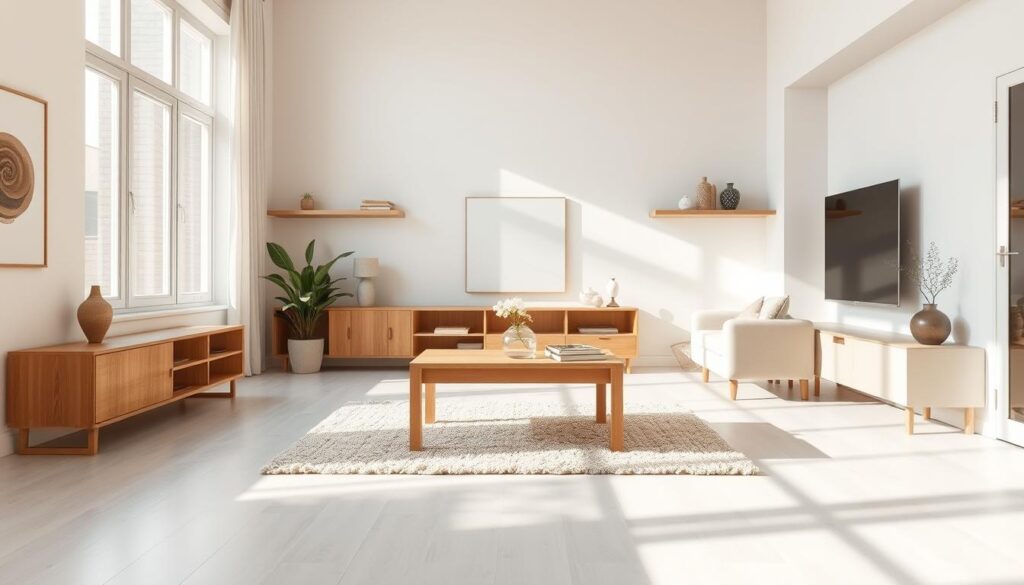In today’s world, we’re often told to buy more. But minimalism offers a fresh way to simplify our lives. The 90/90 Rule is a key part of this movement. It helps you organize and keep your home tidy.
The 90/90 Rule is simple yet effective. It asks you to think about each item in your home. If you haven’t used it in 90 days and won’t in the next 90, it’s time to get rid of it. This rule helps you create a space that’s calm and clutter-free.
By following the 90/90 Rule, you can free up your living space. It’s not just about cleaning up. It also improves your mental health, making you feel less stressed and more content.
Next, we’ll dive into the 90/90 Rule in more detail. We’ll look at its history, how it works, and how to apply it in your life. This guide is for anyone looking to make their home simpler and more peaceful.
Understanding the 90/90 Rule: A New Approach to Minimalism
The 90/90 Rule is a fresh way to declutter and organize your home. It offers a new view on how to live more simply and intentionally. This method is different from old ways of dealing with clutter.
Origins and Philosophy of the 90/90 Rule
Experts created the 90/90 Rule to help people deal with emotional ties to things. It’s simple: if you haven’t used something in 90 days, and won’t in the next 90, it’s time to get rid of it.
Why Traditional Decluttering Methods Fall Short
Old ways of decluttering focus too much on getting rid of stuff. They ignore the emotional and psychological parts of letting go. The 90/90 Rule helps by making you think more about what you really need.
The Psychology Behind the 90-Day Timeline
The 90-day rule is key. It helps us let go of things we think we might need later. By setting a clear time frame, it makes it easier to release items that don’t add value to our lives.

“The 90/90 Rule is a game-changer for anyone seeking to embrace a minimalist lifestyle. It challenges our emotional attachment to possessions and empowers us to create a more intentional and organized living space.”
Learning about the 90/90 Rule can change how you live. It helps you understand why you hold onto things and how to let go. This way, you can live more simply and enjoy your space more.
How the 90/90 Rule Works in Practice
Using the 90/90 Rule for decluttering and minimalist techniques in your home can change your life. Here’s a simple guide to start using this home organization tip:
- Begin by taking a detailed look at what you own. Go through each room, shelf, and drawer. Check every item you have.
- For each item, ask two questions: “Have I used this in the last 90 days?” and “Will I use it in the next 90 days?”
- If the answer to both questions is “no,” then it’s time to let it go. This includes clothes, decorations, gadgets, and more.
- Put items into three piles: keep, donate/sell, and trash/recycle. Be strict with your choices. The goal is to get rid of anything that doesn’t add value to your life.
- After you’ve decluttered, keep the 90/90 Rule in mind. Regularly check your belongings and remove anything that doesn’t meet the criteria.
The 90/90 Rule is flexible and can fit anyone’s lifestyle. It works for minimalists, busy families, or anyone in between. The key is to stay committed and make thoughtful choices about what you keep.
| Advantages of the 90/90 Rule | Potential Challenges |
|---|---|
|
|
By embracing the 90/90 Rule, you can start a decluttering journey. You’ll move towards a more minimalist and organized home. This home will truly reflect your needs and priorities.

Getting Started: Initial Home Assessment
Starting your decluttering journey with the 90/90 rule means first assessing your home. This step is key to a successful decluttering process. Let’s explore what this initial assessment involves.
Room-by-Room Inventory Checklist
First, make a detailed checklist for each room. This will help you see what’s in each area. Include important items like:
- Furniture and large appliances
- Kitchenware and utensils
- Clothing, accessories, and shoes
- Books, magazines, and paper documents
- Electronics and gadgets
- Decorative items and artwork
- Hobby and recreational supplies
Identifying Problem Areas
Now, look at each room with your checklist. Find the areas that are cluttered or not used much. These are your main focus for decluttering. Think about:
- Overcrowded storage spaces
- Unused or outdated items
- Sentimental attachments to possessions
- Lack of organization and clear zones
Setting Realistic Decluttering Goals
After assessing your home, set goals that follow the 90/90 rule. These goals should be clear, measurable, and fit your needs. Here are some examples:
- Clearing out 90% of your linen closet in 90 days
- Reducing kitchen cabinets by 90% in 3 months
- Decluttering your home office by 90% in 90 days
The 90/90 rule helps you make big changes quickly. By setting these goals, you’ll stay on track and motivated.

Common Items That Often Fail the 90/90 Test
Starting your minimalist journey might surprise you. You’ll find some everyday items don’t pass the 90/90 test. This test means letting go of things you haven’t used in 90 days and won’t use in the next 90 days. These unnecessary possessions and clutter culprits can clutter your home, slowing your minimalist path.
Kitchen gadgets are often culprits. Things like juicers and spiralizers take up space and are rarely used. Sentimental items, like old photos or trinkets, can also hold you back from decluttering.
- Unused kitchen appliances and gadgets
- Sentimental items with little practical use
- Hobby supplies and equipment for abandoned pursuits
- Excess clothing and accessories
- Outdated electronics and cords
By using the 90/90 test, we can spot and get rid of these clutter culprits. This makes room for what truly matters and supports our minimalist lifestyle.
| Item | Reason for Failing the 90/90 Test | Suggested Alternative |
|---|---|---|
| Juicer | Used only occasionally, takes up valuable counter space | Manual citrus press or hand-powered blender |
| Sentimental knickknacks | Serve no practical purpose, collect dust | Digitize photos and memories, keep only a few cherished items |
| Unused exercise equipment | Purchased with good intentions but rarely used | Explore bodyweight exercises or outdoor activities |

Getting rid of these unnecessary possessions and clutter culprits frees up space. It lets you fully enjoy the benefits of minimalist living.
Implementing the 90/90 Rule in Different Living Spaces
Using the 90/90 Rule in your home can lead to a minimalist design. It helps you declutter and organize various spaces. Let’s look at how to tidy up your kitchen, dining, bedroom, closet, living room, and common areas.
Kitchen and Dining Areas
The kitchen is a busy spot and can get cluttered fast. Start by sorting through your cabinets, drawers, and pantry. Keep only what you use often, getting rid of the rest. This approach maximizes space optimization in your minimalist home design.
Bedroom and Closet Spaces
Your bedroom should be peaceful and clutter-free. Sort through your closet, dresser, and nightstand. Get rid of items that don’t meet the 90/90 Rule. Use shelves or bins to keep things organized and looking good.
Living Room and Common Areas
Living rooms and shared spaces tend to collect a lot of clutter. Go through magazines, books, and decorations. Keep only what fits your minimalist home design goals. Consider giving away items you no longer need, making these areas more open and inviting.
| Room | Decluttering Focus | Organizational Tips |
|---|---|---|
| Kitchen and Dining | Eliminate rarely used appliances, outdated food, and duplicate cookware | Keep only essential items, maximize cabinet and pantry space |
| Bedroom and Closet | Let go of clothing, linens, and personal items that don’t pass the 90/90 test | Invest in organizational systems like shelves and storage bins |
| Living Room and Common Areas | Evaluate each item, repurpose or donate what is no longer used or meaningful | Free up valuable space by minimizing clutter in high-traffic areas |

By applying the 90/90 Rule to your home, you can achieve a minimalist home design. This approach promotes space optimization and room-specific decluttering. The key is to be thoughtful about what you keep, ensuring it adds value and purpose to your space.
Digital Decluttering: Applying the 90/90 Rule to Virtual Spaces
In today’s digital world, digital minimalism is key to keeping things tidy. The 90/90 Rule helps us clean up our physical spaces. It also works for our online lives and online clutter.
Using the 90/90 Rule for digital decluttering boosts virtual organization and productivity. We can sort through our digital files, emails, and social media. This makes our online life simpler and more focused.
- Begin by checking your digital storage. Look through your computer files, cloud storage, and email. Find things you haven’t used in 90 days.
- Stop getting emails from newsletters and lists you don’t read. Clean up your social media by removing accounts or content that don’t interest you.
- Set up a good digital filing system. Use clear categories and folders to keep everything organized and easy to find.
“The true hallmark of a digital minimalist is the ability to use technology to support your deepest life priorities, without getting caught up in the distractions and time-sucks that come with it.”
Applying the 90/90 Rule to your digital life helps you stay focused and reduces stress. It makes your online space clutter-free. Remember, digital minimalism is about using technology wisely to improve your life and work.

Maintaining a Clutter-Free Home After the Initial Purge
Getting your home decluttered is a big win. But keeping it that way is the real test. To avoid clutter, you need to form new habits and stick to a regular cleaning schedule.
Creating New Habits
To keep your home organized for good, make minimalist habits part of your daily life. Start with simple steps to stop clutter:
- Use the “one-in, one-out” rule for new items
- Get rid of things you don’t use or want
- Have a spot for everything and put things back after use
- Think carefully before buying, choosing quality over quantity
Weekly Maintenance Schedule
To keep your home clutter-free, you need to keep up the effort. Set aside time each week to check your spaces and tackle any clutter issues. Here are some tips:
- Do a quick check of each room to find things to deal with
- Deep clean and organize regularly, like tidying up surfaces and storage
- Plan your week, including time for tasks like laundry or grocery shopping
- Take time to celebrate your success and reward yourself for living minimally
Remember, minimalist habits and a regular cleaning plan are key to a clutter-free home. Stay active and focused on your clutter prevention goals. This way, you’ll enjoy a peaceful, organized living space for years to come.

Conclusion
The 90/90 Rule is a game-changer for minimalism and decluttering. It helps you focus on what’s truly important. This way, you can live a simpler life that boosts your mental health and productivity.
Living with fewer things can really change your daily life. A tidy home brings peace and focus. This leads to better work, less stress, and more joy in your living spaces.
Starting your decluttering journey? Remember, the 90/90 Rule isn’t just for physical stuff. It also works for your digital world. Cleaning up your devices, online accounts, and files brings clarity and control to your digital life.











